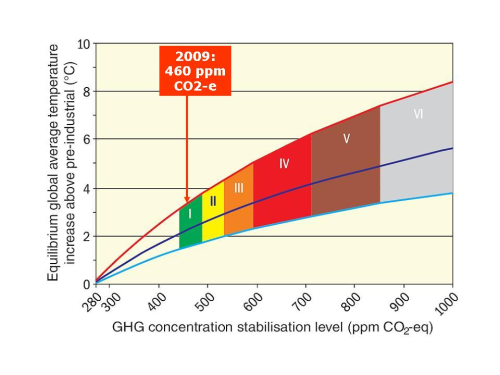The recent warning by Professor Hans Joachim Schellnhuber, Director of the Potsdam Institute of Climate Impact: “We are simply talking about the very life support system of this planet” is consistent with the lessons arising from the history of the Earth’s atmosphere/ocean system.
A rise of CO2-e (CO2-equivalent, including the effect of methane) above 500ppm and of mean global temperature towards and above 4C, projected by the IPCC, Copenhagen and Oxford scientific reports, as well as reports by the world’s leading climate science bodies (NASA/GISS, Hadley-Met, Potsdam Climate Impact Institute, NSIDC, CSIRO, BOM), would transcend the conditions which allowed the development of agriculture in the early Neolithic, tracking towards climates which dominated the mid-Pliocene (3 Ma) (1 Ma = 1 million years) and further toward greenhouse Earth conditions analogous to those of the Cretaceous (145-65 Ma) and early Cenozoic (pre-34 Ma).
Lost all too often in the climate debate is an appreciation of the delicate balance between the physical and chemical state of the atmosphere-ocean-land system and the evolving biosphere, which controls the emergence, survival and demise of species, including humans.
Advertisement
By contrast to Venus, with its thick blanket of CO2 and sulphur dioxide greenhouse atmosphere, exerting extreme pressure (90 bars) at the surface, or Mars with its thin (0.01 bar) CO2 atmosphere, the presence in the Earth’s atmosphere of trace concentrations of greenhouse gases (CO2, methane, nitric oxides, ozone) modulates surface temperatures in the range of -89 and +57.7 degrees Celsius, allowing the presence of liquid water and thereby of life.
Forming a thin breathable veneer only slightly more than one thousandth the diameter of Earth, and evolving both gradually as well as through major perturbations with time, the Earth’s atmosphere acts as the lungs of the biosphere, allowing an exchange of carbon gases and oxygen with plants and animals, which in turn affect the atmosphere, for example through release of methane and photosynthetic oxygen.
Any significant increase in the level of carbon gases triggers powerful feedbacks. These include ice melt/warm water interaction, decline of ice reflection (albedo) effect and increase in infrared absorption by exposed water. Further release of CO2 from the oceans and from drying and burning vegetation shifts of global climate zones toward the poles, warms the oceans and induces ocean acidification.
The essential physics of the infrared absorption/emission resonance of greenhouse molecules has long been established by observations in nature and laboratory studies, as portrayed in the relations between atmospheric CO2 and mean global temperature projections in Figure 1.

Figure 1
A plot of global mean temperature (increase above pre-industrial time in degrees C) vs atmospheric greenhouse gas (GHG) concentration (in CO2-eqivalent, a value which includes the effect of methane).
The assumed climate is 3+/-1.5 degrees C per doubling of CO2-e. The field I, II, III, etc. correspond to the IPCC’s various emission scenarios. IPCC Climate Change 2007: Synthesis Report, figure 5.1.
Advertisement
The living biosphere, allowing survival of large mammals and of humans on the continents, developed when CO2 levels fell below about 500ppm some 34 million years ago (late Eocene). At that stage, and again about 15 million years ago (mid-Miocene), development of the Antarctic ice sheet led to a fundamental change in the global climate regime.
About 2.8 million years ago (mid-Pliocene) the Greenland ice sheet and the Arctic Sea ice began to form, with further decline in global temperatures expressed through glacial-interglacial cycles regulated by orbital forcing (Milankovic cycles), with atmospheric CO2 levels oscillating between 180 and 280ppm CO2. These conditions allowed the emergence of humans in Africa and later all over the world.
Humans already existed 3 million years-ago, however these were small clans which, in response to changing climates migrated to more hospitable parts of Africa and subsequently Asia. About 124,000 years ago, during the Emian interglacial, temperatures rose by about 1 degree C and sea levels by 6 to 8 meters.
Discuss in our Forums
See what other readers are saying about this article!
Click here to read & post comments.
43 posts so far.